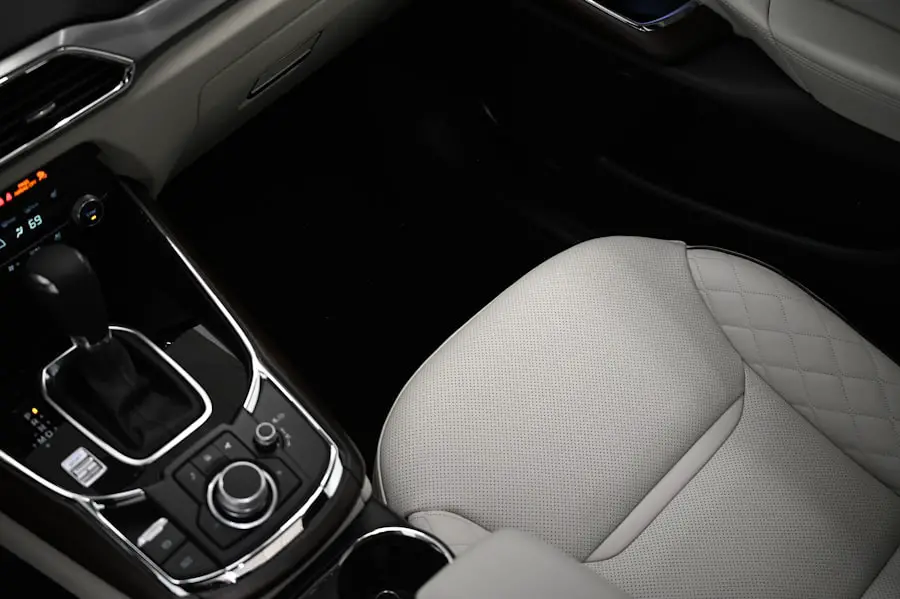Car seats are a fundamental aspect of child safety during travel, serving as a protective barrier that significantly reduces the risk of injury in the event of an accident. The statistics surrounding car accidents are sobering; according to the National Highway Traffic Safety Administration (NHTSA), car crashes are a leading cause of death for children aged 1 to 13. Properly used car seats can reduce the risk of fatal injury by up to 71% for infants and 54% for toddlers.
This stark reality underscores the necessity of ensuring that children are secured in appropriate car seats whenever they are on the road, whether for short trips or long journeys. Moreover, the importance of car seats extends beyond mere compliance with laws; it is a matter of prioritizing the safety and well-being of young passengers. Car seats are designed to absorb impact and protect vulnerable bodies, which are not yet equipped to withstand the forces experienced during a collision.
The design and engineering behind car seats take into account the unique anatomical features of children, ensuring that they are held securely in place and that their heads, necks, and spines are adequately supported. This specialized protection is crucial, especially considering that children’s bodies are still developing and are more susceptible to injury than adults.
Key Takeaways
- Car seats are crucial for the safety of children while traveling in a vehicle.
- It is important to be aware of and comply with car seat regulations and laws in different states and countries.
- There are different types of car seats available for traveling, including infant, convertible, and booster seats.
- When choosing a car seat for traveling, consider factors such as the child’s age, weight, and height, as well as the vehicle’s size and design.
- Proper installation and use of car seats while traveling is essential for ensuring the safety of children in the event of a crash.
Car Seat Regulations and Laws
Car seat regulations vary significantly from one jurisdiction to another, reflecting differing approaches to child safety in vehicles. In the United States, each state has its own laws regarding the use of car seats, often influenced by recommendations from organizations such as the American Academy of Pediatrics (AAP). Generally, these laws mandate that children remain in car seats until they reach a certain age, weight, or height.
For instance, many states require children to be in a rear-facing car seat until they are at least two years old or until they exceed the seat’s weight limit. This is based on research indicating that rear-facing seats provide superior protection for a child’s head, neck, and spine during a crash. In addition to age and weight requirements, some states have specific regulations regarding booster seats and seat belts.
For example, children may be required to use a booster seat until they reach a height of 4 feet 9 inches or until they are between 8 and 12 years old. These laws are designed not only to protect children but also to educate parents about the importance of using appropriate restraints as their children grow. It is essential for parents and caregivers to familiarize themselves with local laws and guidelines to ensure compliance and, more importantly, to safeguard their children’s lives.
Different Types of Car Seats for Traveling

When it comes to car seats, there are several types designed to accommodate children at various stages of development. The primary categories include infant car seats, convertible car seats, booster seats, and all-in-one car seats. Infant car seats are specifically designed for newborns and infants up to about 30-35 pounds.
They are typically rear-facing and feature a carry handle for easy transport outside the vehicle. These seats provide excellent side-impact protection and are often used in conjunction with a stroller system. Convertible car seats offer versatility as they can be used in both rear-facing and forward-facing positions.
This adaptability allows parents to use the same seat as their child grows, making it a cost-effective option. Many convertible seats can accommodate children from birth up to 65 pounds or more, depending on the model. Booster seats come into play once a child outgrows their forward-facing car seat; they elevate the child so that the vehicle’s seat belt fits properly across their body.
All-in-one car seats combine the features of infant, convertible, and booster seats into one unit, providing a long-term solution that can last from infancy through childhood.
How to Choose the Right Car Seat for Traveling
| Factors to Consider | Importance |
|---|---|
| Safety Ratings | High |
| Size and Weight | Medium |
| Installation Method | High |
| Comfort and Support | Medium |
| Adjustability | Medium |
Selecting the right car seat for traveling involves several considerations that go beyond mere compliance with regulations. Parents should assess their child’s age, weight, height, and developmental stage when choosing a car seat. For instance, an infant who is just a few months old will require a rear-facing infant seat, while a toddler may need a convertible seat that can transition as they grow.
Additionally, parents should consider the ease of installation; some car seats come equipped with features like LATCH systems or built-in indicators that help ensure proper installation. Another critical factor is portability, especially for families who travel frequently. Lightweight car seats or those with travel-friendly designs can make it easier to transport children between vehicles or through airports.
Some models even feature removable bases or can be easily converted into stroller systems, providing added convenience for parents on the go. Furthermore, safety ratings should be a top priority; parents should look for car seats that have been rigorously tested and have high safety ratings from organizations such as Consumer Reports or the Insurance Institute for Highway Safety (IIHS).
Tips for Installing and Using a Car Seat While Traveling
Proper installation of a car seat is crucial for ensuring its effectiveness in protecting a child during travel. Parents should always refer to both the vehicle’s owner manual and the car seat’s instruction manual when installing a seat. Many common mistakes occur during installation, such as incorrect angle placement or loose harness straps.
To avoid these pitfalls, parents should ensure that the car seat is tightly secured in the vehicle without excessive movement when pulled at the base. A good rule of thumb is that if you can move the seat more than an inch side-to-side or front-to-back at the base, it is not installed correctly. Once installed, it is equally important to ensure that the child is properly secured in the car seat.
The harness straps should be snug against the child’s shoulders without any slack, and the chest clip should be positioned at armpit level. Parents should regularly check the fit as their child grows; adjusting the harness height and ensuring that clothing does not interfere with proper fit can make a significant difference in safety. Additionally, it is advisable to avoid using bulky winter coats under harness straps, as this can create extra space that compromises safety during an accident.
Alternatives to Bringing a Car Seat While Traveling

Ride-Sharing Services with Car Seats
For families who travel frequently, using ride-sharing services that provide car seats upon request can be a convenient option. Many ride-sharing companies have begun offering vehicles equipped with appropriate child restraints, allowing parents to travel without needing to carry their own seats.
Renting a Car Seat at Your Destination
Another alternative is renting a car seat from rental agencies or baby gear rental services at travel destinations. Many airports and hotels offer rental services for car seats that meet safety standards.
Important Considerations When Renting a Car Seat
While renting a car seat can be convenient, parents should thoroughly inspect any rented car seat before use to ensure it has not been involved in any accidents and is free from damage or wear. Additionally, parents should familiarize themselves with how to install these rented seats correctly since they may differ from their own.
When deciding between renting a car seat or bringing your own while traveling, several factors come into play that can influence this choice. Bringing your own car seat ensures familiarity with its features and installation process, which can alleviate stress during travel. Parents know how to adjust it correctly for their child’s size and have confidence in its safety history since they have used it consistently at home.
On the other hand, renting a car seat can offer convenience, especially for families flying to their destination where transporting bulky items can be challenging. Rental agencies often provide options that meet safety standards; however, there may be concerns regarding cleanliness and previous usage history. Parents should weigh these factors carefully—while renting may save space in luggage, it could also introduce uncertainty regarding safety if not thoroughly checked.
Traveling Safely with Children: Car Seat Considerations
Traveling with children necessitates careful planning around safety measures like car seats. Beyond simply having an appropriate restraint system in place, parents must consider how travel logistics impact their child’s safety during transit. For instance, when traveling by air, parents should plan how they will transport their child from the airport to their final destination—whether by taxi, rental car, or shuttle service—and ensure that appropriate arrangements for a safe ride are made in advance.
Additionally, parents should remain vigilant about maintaining proper usage throughout their travels. This includes regularly checking that harnesses remain snug and secure during long trips and being aware of local laws regarding child restraints at different destinations. By prioritizing safety through informed choices about car seats and travel arrangements, families can enjoy peace of mind while navigating their journeys together.
When traveling with young children, it is important to consider whether or not you need to bring a car seat. According to a recent article on taketravelinfo.com, bringing a car seat can provide added safety and peace of mind while on the road. It is always recommended to check the specific regulations and requirements of your destination to ensure that you are properly prepared for your journey.
FAQs
What are the regulations for using a car seat when traveling?
In many countries and states, it is required by law to use a car seat for infants and young children when traveling in a vehicle. The specific regulations may vary, so it is important to check the laws of the destination you are traveling to.
Do I need to bring a car seat when traveling by plane?
When traveling by plane, it is not necessary to bring a car seat unless you plan to use it in a vehicle at your destination. Most airlines allow infants and young children to sit on an adult’s lap during the flight, or provide special infant seats if requested in advance.
Should I bring a car seat when renting a car at my destination?
It is recommended to bring a car seat when renting a car at your destination, especially if you will be traveling with young children. While some car rental companies may offer car seats for an additional fee, it is often more convenient and cost-effective to bring your own.
What are the benefits of bringing a car seat when traveling?
Bringing a car seat when traveling provides added safety and security for infants and young children when riding in a vehicle. It also ensures that you have a familiar and properly fitted car seat for your child, rather than relying on the availability and condition of rental car seats.

2 thoughts on “Do I Need a Car Seat When Traveling?”